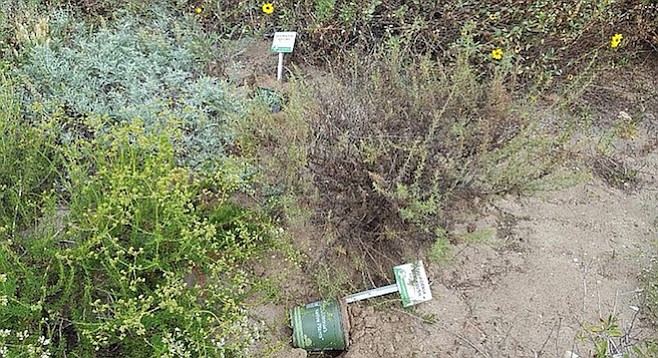 Facebook
Facebook
 X
X
 Instagram
Instagram
 TikTok
TikTok
 Youtube
Youtube

On Earth Day (April 22), Joel Kalmonson was checking on the Ocean Beach Native Plant Garden when he found all 24 of the plant identification markers knocked over. Kalmonson is a lead volunteer who regularly visits to check on the health, maintenance issues, and overall state of the garden.
The garden is located near Dog Beach, at the end of Voltaire Street behind the Ocean Villa Hotel. Sarah Hutmacher is the associate director of the San Diego River Park Foundation and is responsible for coordinating more than 6000 volunteers.
“We haven’t heard any reports from anyone who may have seen something,” Hutmacher said when asked if she had any idea of who might have knocked the markers down. “Luckily, this time the signs were just knocked over and not stolen or damaged beyond repair….
“The foundation works to maintain and restore many sites along the San Diego River from Ocean Beach all the way up to Julian,” Hutmacher continued, “and vandalism is a frequent issue. Sometimes, like this time, we get lucky and our volunteers are able to make repairs and get everything good as new. Other times, when repairs or replacement are more expensive, the public spaces suffer because we need to identify funding to fix the issue, which can sometimes take months or longer.”
Hutmacher said the native plant “demonstration garden” signage was made possible through the support of a grant from the Ocean Beach Town Council in 2015.
“The river mouth [where the river meets the Pacific Ocean in O.B.] is home to thousands of native plants and dozens of different species,” said Hutmacher. “One of the rarest plants [found on the dunes] is the salt marsh bird’s beak [an endangered plant]. The demonstration area which features the plant identification signs is home to San Diego’s sunflower, cliff spurge, sea dahlia, bladder pod, sages, and more.”
While the San Diego River is 52 miles long, Hutmacher said the river mouth in Ocean Beach is by far the most visited section.
“Many scientists estimate that only 5 percent of the coastal wetland ecosystems that used to dominate the Southern California coastline remain today,” said Hutmacher, “which puts incredible pressure on the remaining habitats to support important functions like providing for wildlife. Protecting these areas and engaging the community in caring for them is central to the foundation’s mission.“
The foundation is always in need of more volunteers.
“People can help by volunteering, by learning about these special resources or by reporting any suspicious activity or damaged signage or amenities,” said Hutmacher. “We have regular work parties at the O.B. Native Plant Garden. However, we have an extra special interactive educational event for kids and families on May 14.”
(revised 4/27, 10:25 a.m.)


On Earth Day (April 22), Joel Kalmonson was checking on the Ocean Beach Native Plant Garden when he found all 24 of the plant identification markers knocked over. Kalmonson is a lead volunteer who regularly visits to check on the health, maintenance issues, and overall state of the garden.
The garden is located near Dog Beach, at the end of Voltaire Street behind the Ocean Villa Hotel. Sarah Hutmacher is the associate director of the San Diego River Park Foundation and is responsible for coordinating more than 6000 volunteers.
“We haven’t heard any reports from anyone who may have seen something,” Hutmacher said when asked if she had any idea of who might have knocked the markers down. “Luckily, this time the signs were just knocked over and not stolen or damaged beyond repair….
“The foundation works to maintain and restore many sites along the San Diego River from Ocean Beach all the way up to Julian,” Hutmacher continued, “and vandalism is a frequent issue. Sometimes, like this time, we get lucky and our volunteers are able to make repairs and get everything good as new. Other times, when repairs or replacement are more expensive, the public spaces suffer because we need to identify funding to fix the issue, which can sometimes take months or longer.”
Hutmacher said the native plant “demonstration garden” signage was made possible through the support of a grant from the Ocean Beach Town Council in 2015.
“The river mouth [where the river meets the Pacific Ocean in O.B.] is home to thousands of native plants and dozens of different species,” said Hutmacher. “One of the rarest plants [found on the dunes] is the salt marsh bird’s beak [an endangered plant]. The demonstration area which features the plant identification signs is home to San Diego’s sunflower, cliff spurge, sea dahlia, bladder pod, sages, and more.”
While the San Diego River is 52 miles long, Hutmacher said the river mouth in Ocean Beach is by far the most visited section.
“Many scientists estimate that only 5 percent of the coastal wetland ecosystems that used to dominate the Southern California coastline remain today,” said Hutmacher, “which puts incredible pressure on the remaining habitats to support important functions like providing for wildlife. Protecting these areas and engaging the community in caring for them is central to the foundation’s mission.“
The foundation is always in need of more volunteers.
“People can help by volunteering, by learning about these special resources or by reporting any suspicious activity or damaged signage or amenities,” said Hutmacher. “We have regular work parties at the O.B. Native Plant Garden. However, we have an extra special interactive educational event for kids and families on May 14.”
(revised 4/27, 10:25 a.m.)
Comments